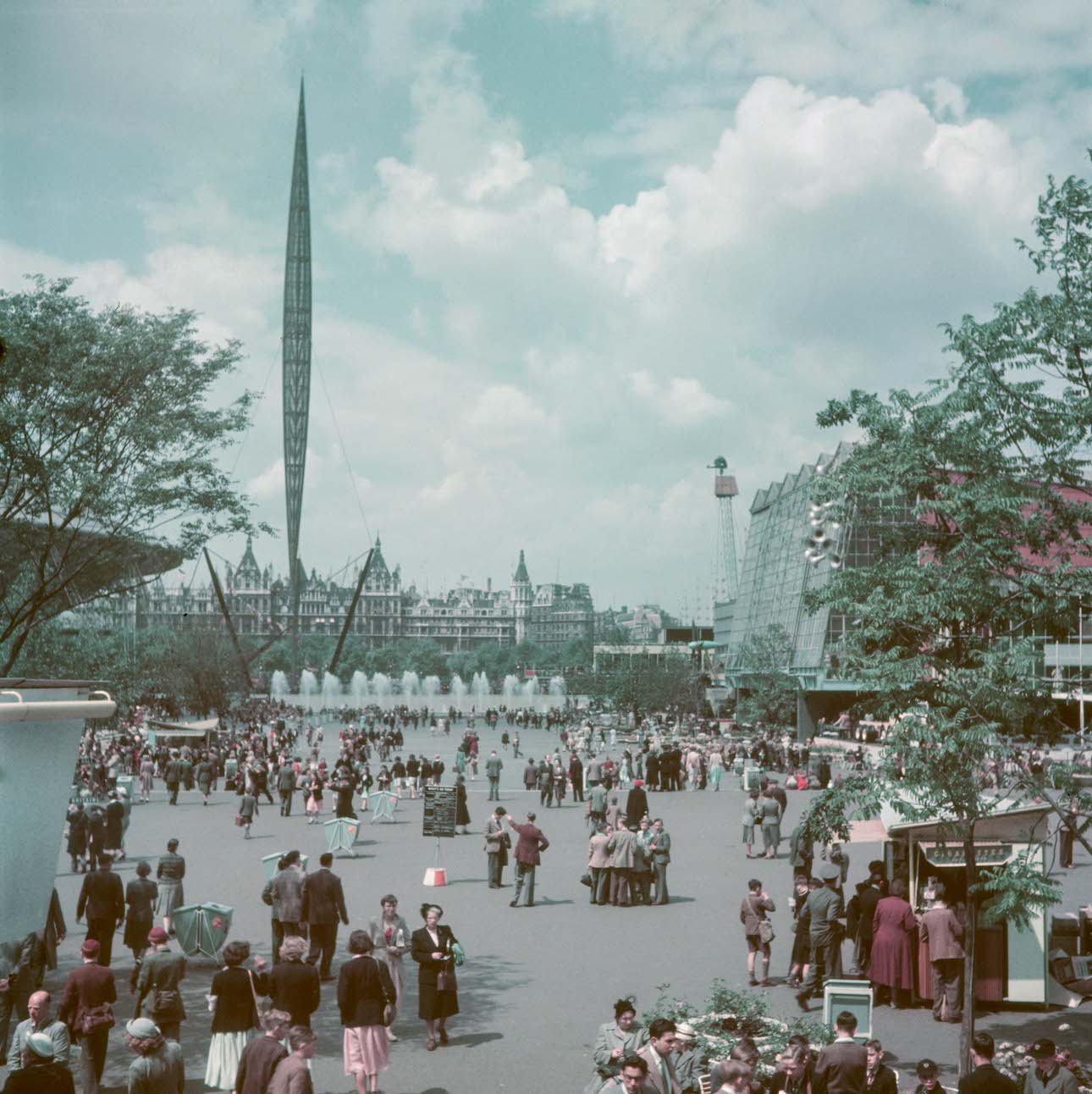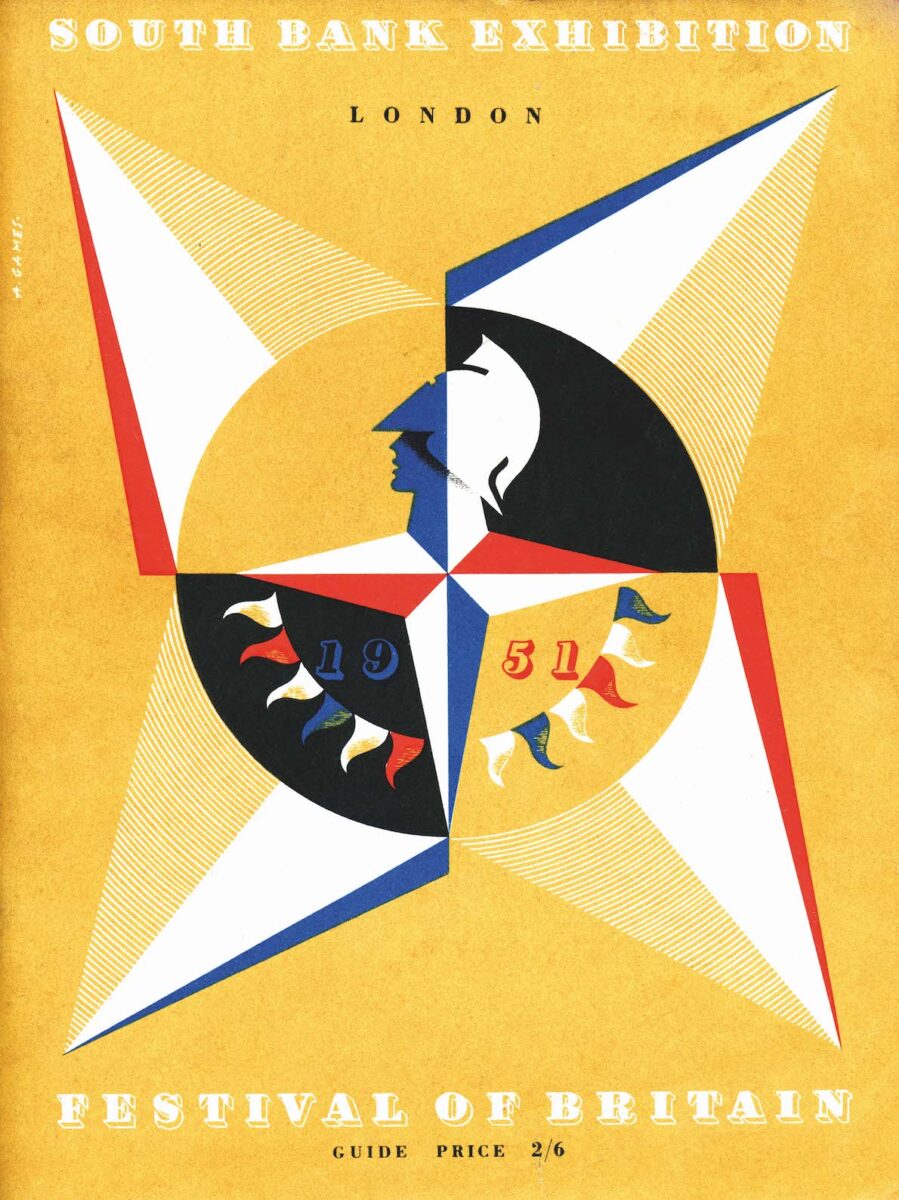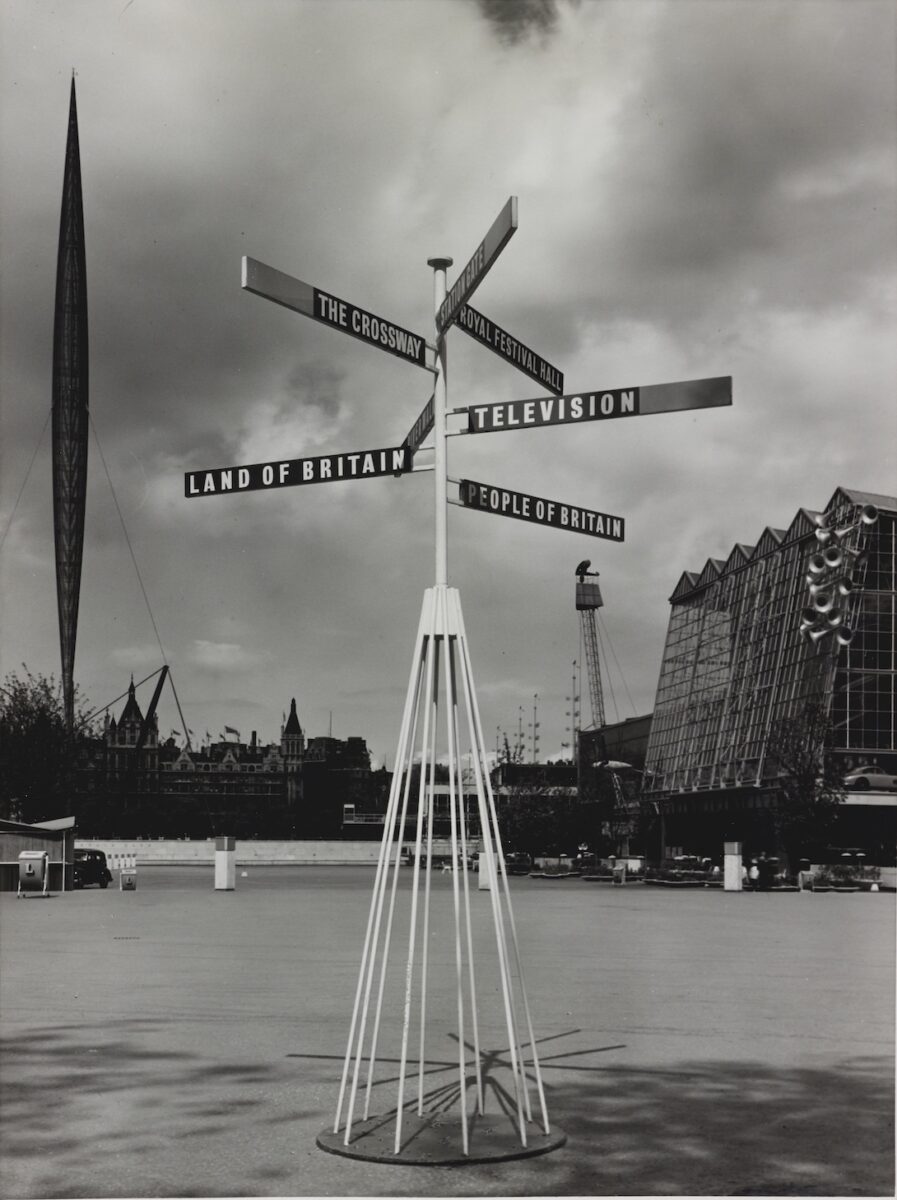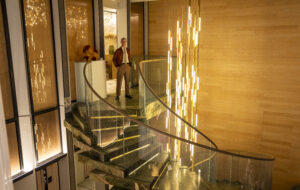The 1951 festival has long been the victim of selective memory. As the British people gird themselves for a sequel, it’s time we got the story straight

Words by John Jervis
For better or worse, the visual arts haven’t featured large in Britain’s national mythologies of late. Yet, in September 2018, Theresa May launched what is now known as Festival UK* 2022, proclaiming: ‘Just as millions of Britons celebrated their nation’s great achievements in 1951, we want to showcase what makes our country great today.’ This ‘Festival of Brexit’ was met with scorn, hilarity and anger among artistic communities – followed, last year, by infighting and accusations of hypocrisy as groups from Assemble to the White Pube accepted the government’s shilling.
So far, so normal. More interesting is that May chose to leverage popular affection for the Festival of Britain in her flawed attempt to heal the wounds of Brexit. Why, 70 years on, does this one cultural event – first proposed in 1943 as a commemorative rehash of the Great Exhibition (with a not-dissimilar mix of industry and imperialism) – endure in the national imagination, symbolising the social-democratic identity of post-war Britain?
One vital factor in this tenacity is the Festival’s rapid abandonment of its predecessor’s internationalism, in large part due to financial constraints, with Labour’s deputy prime minister Herbert Morrison demanding domesticity: ‘Something jolly… something to give Britain a lift’. The principal result, the Land and People exhibition on London’s South Bank, was housed in determinedly non-totalitarian architecture scattered across an informal landscape, with partisanship, commerce and imperialism largely eschewed. There were major exhibitions in Glasgow and Belfast; the Lansbury Estate – ‘a cross-section of a neighbourhood’ – in east London; pleasure gardens in Battersea; two travelling displays, one on a converted aircraft carrier; and over 2,000 events in cities, towns and villages across the country.
In wider contexts, historians have long paid the festival little mind. Those on the right tend to give it only a cursory nod. Left-wing counterparts admit flaws but salute its aspirations – Kenneth Morgan called it a ‘triumphant success’ while regretting its Little Englander tendencies. Within the arts, however, the festival has played a far more central role, widely denigrated both then and now for its provincialism and mediocrity; as a Trojan horse for consumerism; and for its half-hearted approach to socialism and culture.
At the time, the festival’s architecture attracted faint praise from Le Corbusier, Frank Lloyd Wright and John Summerson. More acerbic voices attacked its betrayal of modernism’s heroic qualities – its rigour and social clarity – an opinion asserted forcefully by associates of the radical Independent Group. These included Reyner Banham (for whom it ‘left only a few travesties behind’); Colin St John Wilson (who attacked Lansbury’s ‘extraordinary effeminacy’); and James Stirling (for whom ‘Festivallian’ was a favourite insult). Particularly trenchant were Alison and Peter Smithson, smarting from unplaced competition entries for both the festival and Coventry’s new cathedral, and soon to proclaim an antagonistic New Brutalism. Support for the festival from the Architectural Review – a champion of Picturesque principles, ‘followed with triumphant results’ on the South Bank – only confirmed detractors in their hostility.

A view of the Festival of Britain site, with the Skylon on the left, on the South Bank, London, 1951. Photo: Paul Popper/Popperfoto/Getty Images
It took longer for political disdain to reach maturity. It did so thanks to a brilliant article, ‘Festival’, written in 1963 by the young playwright Michael Frayn and famous for proposing a post-war fissure among the privileged classes. Conservative ‘Carnivores’, disgusted at ‘the gestation of a monstrous new state, in which their privileges would be forfeit’, turned on the festival, employing media magnate Lord Beaverbrook as a cudgel. Frayn defines his alternative elite, the ‘Herbivores’, as ‘the radical middle-classes – the do-gooders; the readers of the News Chronicle, the Guardian, and the Observer; the signers of petitions; the backbone of the BBC’, for whom the festival was the ultimate expression of patrician aspirations.
Frayn’s essay had weaknesses. Those he wheeled out as Carnivores – Evelyn Waugh, Cyril Osborne and Beaverbrook – were acknowledged reactionaries far from representative of mainstream Conservative opinion. And he was premature in announcing the Herbivore era’s demise, symbolised by the Conservatives’ clearance of the South Bank ‘with almost guilty haste’. In these regards, his article was a product of the cynicism pervading journalism and academia in the early 1960s.
Frayn’s critiques hardened into dogma with the V&A’s A Tonic to the Nation exhibition, mounted in 1976 to celebrate the festival’s 25th anniversary. The catalogue compiled reflections from participants and visitors, bookended by critical essays. The latter were combative. William Feaver smirked at the festival’s ‘medium wavelength’ art, barrel-shooting artists whose reputations had been in abeyance for decades, recusing only such Independent Group affiliates (and 1970s darlings) as Eduardo Paolozzi and Victor Pasmore. He also ridiculed visitors for embracing a banal ‘Festival Style’ which he defined as ‘colour-rinse concrete, lily of the valley splays of light bulbs, cane work, aluminium lattices’. And he lambasted Basil Spence’s Coventry Cathedral as ‘the apotheosis of the Festival’.
Contributions from Bartlett colleagues Adrian Forty and Reyner Banham shared Feaver’s tendency to infantilise the festival’s visitors. Forty employed Frayn’s herbivore/carnivore metaphor to depict it as an isolationist ‘narcotic for the nation’, distracting the masses from broken promises with an image of ‘what Britain might be like with full employment and a welfare state’ that was ‘illusory and partly false’.
According to Forty, the festival advocated that ‘happiness could be found through material possessions and plenty of shiny paint’, yet appreciation of its designs was limited: ‘For the crowd, it was enough for the contents… to be new and unusual.’ Forty’s most pungent contribution was to brand Churchill the ‘greatest Carnivore of all’, picking ‘the Festival as the particular target on which to concentrate his most vituperative criticisms of [Labour’s] domestic policy’, encouraging the excesses of Beaverbrook’s newspapers, and erasing away this ‘socialist Festival of Britain’ upon closure. This last claim was sensationalised in the exhibition’s press release, which declared that the South Bank ‘was deliberately obliterated… by the new government’.

Cover of the official Festival of Britain Guide to the South Bank Exhibition London. Image: Alamy
Equally influential was Banham’s contribution, ‘The Style: “Flimsy … Effeminate”?’, which portrayed an establishment fixated on the festival as a moment of cultural renewal, when in reality its style had, he believed, ‘died a-borning’. Mild quotes from organisers such as Misha Black (‘The Festival… gently pushed forward an existing style – it did not create one’) were presented by Banham as hard-won admissions rather than long-held opinions.
Yet few had ever pretended that the Festival of Britain had enduring or international significance. One participant stated that it ‘marked the ending of a style, not the beginning’, while its architectural director described it as ‘a giant toyshop for adults … light-hearted, sensible, not too serious’. The only real evidence Banham offered for the existence of this surprisingly ineffective establishment attempt to guard the flame of a Festival Style came in the questionable form of quotes from cartoonist Osbert Lancaster.
In truth, the festival’s major stylistic legacy, outside domestic and retail interiors, was the backlash it sparked. The completion of Spence’s Coventry Cathedral in 1961 met with a widespread critical shrug – the Independent Group’s influence already pervaded architecture, epitomised by the shuttered-concrete South Bank Centre rising alongside the Festival Hall.
Yet given the profession’s mid-1970s crisis, A Tonic to the Nation proved an ideal vehicle to renew claims to victimhood – heroic tales of modernist rigour and establishment enmity flattered its vanity far too much to be seriously interrogated. Even today, broadsheet journalists repeat them faithfully, convinced they are engaged in some novel act of iconoclasm, now spiced up with a quote from Churchill describing the festival as ‘three-dimensional socialist propaganda’ that seems to be absent from any contemporary source. In contrast, attempts to empathise with the festival’s mind-set are dismissed as ‘dewy-eyed’.
Even so, new perspectives are emerging from academics such as Alayna Heinonen, Iain Wilton and Becky Conekin. Digging into the festival’s displays (a challenge often shirked) has raised important questions around the determinedly domestic role allotted to women; the suppression of Victorian industrial and urban achievements for an essentially bucolic, libertarian English identity; problematic tributes to exploration and discovery, couched in deliberately ambiguous language; and the failure to celebrate post-Norman immigrant communities, despite their vital role in the festival’s architecture and design.

Festival of Britain signage by Robin Day and others, 1951. Photo: Robin & Lucienne Day Foundation/Alfred Cracknell
It has also become clear that the mainstream press, bar Beaverbrook, was vigorous in its support of the festival, as were most Conservatives, particularly within Parliament – Attlee even wrote to thank Churchill for his backing. There is no evidence that Churchill and Beaverbrook ever discussed the festival, nor is it mentioned in Churchill’s copious correspondence with Beaverbrook’s editors – by all accounts he just wasn’t that interested. Almost all of the government’s proposals regarding the festival were approved in Parliament ‘on the nod’. The one defeat, on Sunday opening at Battersea’s pleasure gardens, came courtesy of a ‘sabbatarian, anti-hedonist lobby’ (in Forty’s words; however, he fails to mention that this included 144 Labour MPs).
Nor was the clearance of the South Bank a Conservative initiative, despite the new minister of works, David Eccles, pushing for haste, stating that he did not want to be ‘caretaker of empty and deteriorating structures’. The decision not to extend the festival had been taken three months earlier under Labour, with a Demolition Working Party instructed to clear the site by the end of the year, backed by London County Council. Staff were laid off, auctions prepared, bulldozers sent in and a large hole cut into the Dome of Discovery to empty its interior. Hopes remained of retaining or re-siting the more celebrated buildings, but negotiations stalled on costings and price.
The festival’s insularity has also been overstated. Concerted efforts to involve the Commonwealth were made, promoted by ministers such as Ernest Bevin who hoped to demonstrate Britain’s commitment to self-governance. These attempts foundered on the ineptitude of organisers, but also on the refusal of Commonwealth countries, new and old, to present themselves as little more than grateful recipients of Britain’s supposed ‘gifts to the world’. This trope remained prevalent in displays, with parliamentary democracy, the English language, railways, free trade and football offered as examples. That their spread was, at best, a by-product of colonial exploitation, passed unmentioned.
Thanks to Brexit, crude right-wing takes on the festival emerged from commentators such as Dominic Sandbrook, chiming with ludicrous fantasies steeped in imperial nostalgia around standing alone, taking back control, island races and global reach. The Festival of Britain was staged at a parallel moment of national fragility over national and international identity, economic and social struggle and cultural disorientation. Its attempts at a ‘united act of national reassessment’, in the words of its official guide, may have been archaic, partial and class-ridden but, when compared to our current discourse, its regard for tolerance and diversity, and its belief in the power of the arts, deserve credit.
Writers who might, one hopes, appreciate at least some of these virtues have long preferred to take childish delight in the incessant repetition of mantras drawn from the yellowing pages of Frayn, Forty and Banham – and the lumbering spectacle of Festival UK* 2022 has provoked a further litany. This may be cathartic but, like much journalism in the age of instant news, such ritualised iconoclasm, delivered with unwavering belief in its own moral authority, does not allow much in the way of subtlety, balance or self-interrogation. Instead, it produces polarisation.
The trauma unleashed by Brexit, and the bizarre prospect of a new national festival to mitigate against this self-inflicted wound, should not be used as a prism with which to view the Festival of Britain. A few months after its closure, festival director Gerald Barry wrote that its role was to ‘assert the strength and value of the democratic way of life at a time when it was being subjected to sharp strains and challenges’. Call me naïve, but that seems like an ambition to be celebrated.
This article is an edited update of a piece originally published in ICON #190, April 2019
















